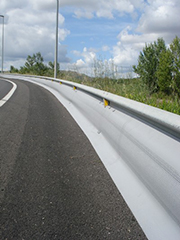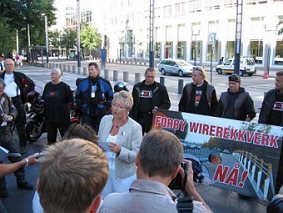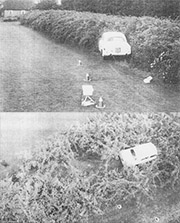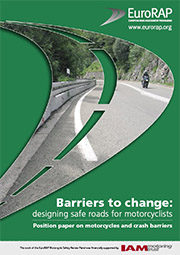Potted History
 In Europe it would appear that the issue was first raised seriously in 2000 with the publication of the “Final report of the Motorcyclists & Crash Barriers Project”.
In Europe it would appear that the issue was first raised seriously in 2000 with the publication of the “Final report of the Motorcyclists & Crash Barriers Project”.
Although back in the early nineties DMC, together with the Motorcycle Safety Group, MCSG, fought against cable barriers. Within a period of 8 years, the hundreds of kilometers of cable barriers were replaced by steel barriers, and cable barriers would not be used in the future. The last cable barriers was removed from Danish roads in 2002.
The project which led to the “Final report of the Motorcyclists & Crash Barriers Project” was supported by the Directorate General for Energy and Transport of the European Commission, with an aim to develop recommendations to Road Traffic Authorities for reducing injuries to motorcyclists in collision with crash barriers.
The emphasis was given to low-cost protective measures and preferred crash barrier systems and installation practices in order to develop recommendations to Road Traffic Authorities for reducing injuries to motorcyclists in collision with crash barriers.
In 2001 the European Parliament (EP), as a result of the report, adopted in a resolution on the ‘Priorities in EU road safety’, as highlighted in the following text:
“Whereas such a policy might require major investment to plan and build a safe traffic system; but whereas low-cost road engineering measures, such as safety barriers, may be implemented quickly and, like the production and promotion of EU technical guidelines based on best practices, may significantly improve traffic safety; whereas, however, the safety barriers must meet the specific safety requirements of motorcyclists”.
 Since the report was published until 2005, several rider organisations in Europe worked with road authorities to improve existing crash barriers to adapt them to the safety needs of motorcyclists. Most successful was MAG Netherlands in gaining commitment from government to authorise the removal and no further fitment of wirerope barriers and the fitting of motorcycle friendly guardrails.
Since the report was published until 2005, several rider organisations in Europe worked with road authorities to improve existing crash barriers to adapt them to the safety needs of motorcyclists. Most successful was MAG Netherlands in gaining commitment from government to authorise the removal and no further fitment of wirerope barriers and the fitting of motorcycle friendly guardrails.
However, nothing much happened to the commitment from the European Parliament, all appears to have sunk without trace.
In 2005 Morten Hansen – Norsk Motorcykkel Union (NMCU) – Norway, Wim Taal Motorcyclists’ Action Group (MAG) – the Netherlands and Write To Rides, Trevor Baird, then working for the Motorcycle Action Group (MAG) United Kingdom produced a FEMA document “The Road To Success – improving motorcycle safety by improving crash barriers”, using information and data provided by all 22 member organisations.
This document gave an overview of the projects that have been successfully carried out in a number of European countries, it will also described the difficulties and obstacles that motorcyclists’ organisations encounter regarding crash barriers.
In June 2008, CEN members voted to improve the standard of safety barriers to take motorcyclists into account and reduce injuries and fatalities.
The Committee of European Normalization (CEN) mandated the drafting of a new part to the European Standard for road restraint systems (EN1317-8), so that motorcyclists would benefit from roadside barriers studies, designed and tested with their specific safety in mind.
 There is however, debate regarding motorcyclists and the EN1317-8 standard, due to the fact that some pressure groups would like immediate recognition of motorcyclists based on the Spanish guidelines they are promoting, which only tests motorcycle friendly barrier systems with a sliding dummy in their standard (one of the issues with this is that the dummy is not a “motorcycle dummy” but is an adaptation of a car dummy).
There is however, debate regarding motorcyclists and the EN1317-8 standard, due to the fact that some pressure groups would like immediate recognition of motorcyclists based on the Spanish guidelines they are promoting, which only tests motorcycle friendly barrier systems with a sliding dummy in their standard (one of the issues with this is that the dummy is not a “motorcycle dummy” but is an adaptation of a car dummy).
Other road safety technicians would prefer to include more specific crash scenarios, including riding the motorcycle with rider sitting on it, as well as different collision angles and so forth.
So what you would think would be a relatively simple matter, has ended up in committee (TC226/WG1) with riders’ organisations and traffic safety engineers seemingly frustrated with industry and their economical interests disrupting a process to safe riders’ lives
Ultimately the various European countries need to work together to ensure that crash barriers are fit for purpose, especially with regards to motorcyclists.
The Hedge – 1966
 Back in 1966 the UKs Ministry of Transport through the Road Research Laboratory published a report regarding vehicle impact tests on the serious consideration of using hedging – Rosa Multiflora Japonica – to prevent vehicles crossing into the opposite carriageway.
Back in 1966 the UKs Ministry of Transport through the Road Research Laboratory published a report regarding vehicle impact tests on the serious consideration of using hedging – Rosa Multiflora Japonica – to prevent vehicles crossing into the opposite carriageway.
With testing of the hedging reminiscent of a “British Boffin” development of secret weapons, the driver of the vehicle, it would appear there was no crash test dummies in those days, was instructed to drive at a steady approach speed and not to brake, accelerate, or attempt to steer the vehicle while in the hedge.
The report concluded that, “The earth strip of the central reserve on British motorways is 13 ft wide, so that the maximum width of hedge that could be planted would be about 10ft.”
“It is evident that a hedge of rosa multiflora Japonica would not be a positive barrier for vehicles traveling at full motorway speeds, since it would stop those fast-moving vehicles only if they entered the central reserve at very small angles to the line of the hedge.”
“It would, however, produce an appreciable reduction in speed, and for slower impacts at small angles the car could be retained within the central reserve. “
“Braking or speed reduction due to skidding before crossing the central reserve would often lower the impact speed with the hedge or present a greater surface area to the hedge.”
“Such a hedge would also cut out glare from approaching headlights at night.”
Thankfully the idea never realised its full potential, while no motorcycles were tested maybe the “scientists” had considered motorcyclists as the six-year-old variety of 20 ft thick rosa multiflora Japonica, was of a thornless shrub rose.
While recognising that crash barriers are required to prevent cross over collisions, development of barriers have moved on since the hedge, motorcycle friendly crash barriers have been produced, tested and tried using far superior modern procedures and materials, however barriers that stand alone for the protection of other vehicles are still not motorcycle friendly.
 We hope with the work being done at European standard level will change this this somewhat, it is how this is implemented in the “real world” for motorcyclists to be taken into consideration.
We hope with the work being done at European standard level will change this this somewhat, it is how this is implemented in the “real world” for motorcyclists to be taken into consideration.
This is because new road projects, for example in Northern Ireland A5 Western Transport Corridor, the retro fitting of motorcycle friendly systems and in fact reviewing roadside restraint systems without protection, which have been already fitted, (not to mention the auditing of these systems regarding motorcycle safety) implies significant extra cost.
The cost may be the actual barrier as agencies put into place cost benefit analysis of money to be spent .
However the document produced by EuroRap – “Barriers to Change: designing safe roads for motorcyclists – December 2008” recommends the use of the “Dutch decision tree” (Annex 1) and says that:
“Road engineers urgently need clear criteria for the design of crash barriers and guidance on where they should be implemented, in the same way that they are available for passively safe support structures such as lampposts and lighting columns. The Netherlands, for example, already use a decision tree approach to guide them through the selection process. In the absence of a pan-European approach, such in-country examples provide a good basis for others to adapt to their own circumstances.”
The EuroRap document also states that, “A technical design manual is needed that includes a clear formula for the implementation of systems appropriate to a specific site or route, both on existing roads and on new builds.”
“Until such time, in the light of evidence suggesting a high risk to PTWs, road engineers should be encouraged to question the need for a crash barrier in the first instance.”
So rather than a hedge a whole tree is needed to protect motorcyclists regarding crash barriers.
Vehicle Impact Tests On A Hedge Of Rosa Multiflora Japonica – 1966 pdf 330kb
EuroRap – Barriers to Change: designing safe roads for motorcyclists – December 2008 pdf 2.2mb
.



Speak Your Mind